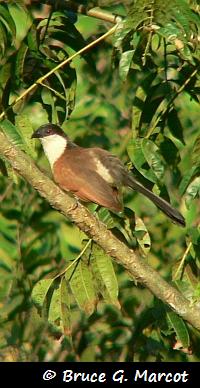|
Explanation: OK,
I admit it. I thought it was an owl. At first, anyhow. When
I first encountered this locally common but furtive
bird, it was well after
dark in one of the remote local mud-and-thatch-hut villages near Lake Tumba in
the Congo River Basin of central tropical Africa. I was on the hunt for owls, as I often
am on these expeditions.
for owls, as I often
am on these expeditions. Suddenly,
in the tall trees outside my hut, in the darkness of a moonless night, I heard
it calling ...
 Click button for Senegal Coucal song
Click button for Senegal Coucal song
(© Bruce G. Marcot)
An owl! But wait, I know all the owl songs and calls of the Congo, and
this was unlike any I had heard before. Moreover, there were suddenly three
of them calling at once, each from the dense foliage of a tall tree near the
village opening. I grabbed my recorder and captured the song for later
identification, returning to my bedroll as the sounds of insects, frogs,
and this unknown songster continued to penetrate the night.
Later,
in another village, I solved the mystery. This is a species of cuckoo
called the Senegal coucal,
which is actually fairly widespread
in central Africa. They often occur singly or in pairs, and sometimes
sing in duet, and can indeed be found in dense tree or shrub foliage within or
on the margins of jungle villages. But
none of the bird books and information I have on this species notes that it
can sing in the dead of night, like an owl. This
was a good learning experience, too, not to jump to conclusions about
identifying a sound without further exploration ...
Postscript: I recently viewed an
episode of the TV show "Destination Truth" on the SyFy
channel, in which the intrepid, if not inexperienced, hunters of "cryptids"
(undescribed, fantastic species) were in search of a "terrifying"
forest creature of Gambia known as Kikiyaon. First,
the description of the creature -- "resembling a large owl of human
proportions [with] a large beak and raking talons on its arms and feet"
with "a huge pair of feathered wings..." -- sounds pretty much
like a well-known species of owl known variously as the Giant Eagle-owl or
Verraux's Eagle-owl (Bubo lacteus) (see my
photos of this species, including its "raking talons," on my
owls web site). Second, the team does not
encounter a Kikiyaon, but they do hear and record a hooting sound emanating
from a tree. It is clearly, identically, the same as the recording in
this week's EPOW episode, thus that of a Senegal coucal. What
is most bothersome about this show episode (if not most of this series) is
that they do little to no research whatsoever to identify their
encounter. They play the recording for a supposed retired zoo curator,
who clearly declares that "it is some sort of owl." This
was dead wrong. (I wondered if the curator had ever studied bird songs
in Africa.) I don't mind an initial misidentification (I too
first thought "owl" but had already learned all the owl calls of
the region I was studying), but it should have been stated as a hypothesis,
and then validated or falsified by further research. For example, I
carefully waded through dozens of bird songs on the CD set "African
Bird Sounds" (Chappuis 2000) until I located one that seemed to fit my
recoding; and then I created and compared sound spectrograms of my recording
and of the recording on the CD, analyzed them, and discovered that they
matched in pitch, call-note frequency, cadence, etc. This confirmed
identification of the species as Senegal coucal. And yes,
"Fy" in "SyFy" means "fiction" (as in science
fiction), but to do so poor a job with ostensibly a valid field expedition
confers no confidence in what is presented. May the viewer beware.
Chappuis, C. 2000. African bird sounds.
Birds of north, west and central Africa. 15-CD set. With the collaboration
of the British Library National Sound Archive (London). Société
d'Études Ornitholgiques de France, Paris, France. 191 pp. booklet + 15
CDs.
|
Index |
Location | Search | About EPOW | ... Next >